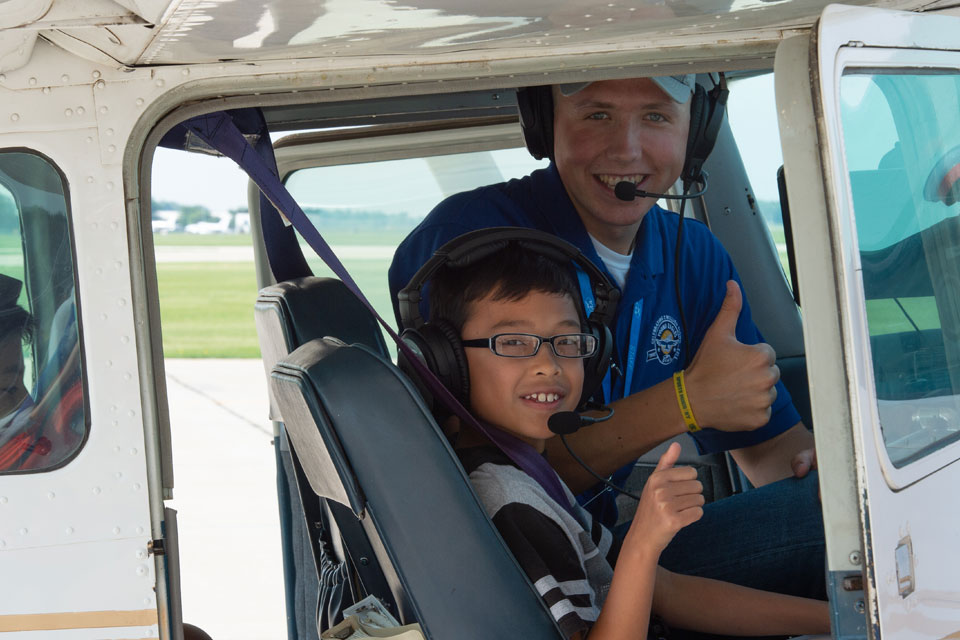Five Tips for Improving the Young Eagles Flight Experience— Part 4 of 5
By David Leiting, EAA Lifetime 579157
February 2022 – Young Eagles rallies are often a marquee event for EAA chapters. Some chapters host one or two large rallies per year, flying between 50 and 100 youths, while others host these events monthly and cap the number of flights at 20 or 30 participants. No matter the size of the event, chapter leaders spend significant time on planning the event. What the facility set-up will look like, who will be volunteering to check in youth or park aircraft, and sometimes even what food will be served are considerations. All of this planning is critical to a successful Young Eagles rally.
Despite all this planning, how often are best practices shared for providing the best possible flight experience? The better the experience, the more likely the youth is to latch on to an interest in aviation. After all, the world’s best pancakes are no good if the proceeding flight isn’t enjoyable.
Over the next few months, EAA will feature five surefire tips for improving the Young Eagles flight experience at your chapter’s next rally.
Five Tips for Improving the Young Eagles flight experience:
- Fly One Young Eagle at a Time
- Involve the Young Eagle in the Aircraft Walk Around
- Provide a Thorough Passenger Briefing
- Narrate the Flight
Finally, the highlight of the event has arrived— for the youth and the pilot. Pilots will encounter a wide variety of personalities when flying Young Eagles— everything from shy and timid, to excited and talkative. Narrating the flight is a great way to help bring a youth out of their shell, or settle an overly excited passenger.
While taxiing out, if work load permits, pilots can point out how the aircraft is controlled on the ground with the rudder pedals. Taxi time may also present the opportunity to explain a bit about how taxiways and runways are named and identified.
During the engine run-up, pilots are provided the opportunity to talk through this procedure. This also presents another opportunity to ease the Young Eagles’ nerves by explaining that this run-up is completed to ensure the aircraft is suitable for flight.
As the aircraft is pulled onto the runway, pilots may want to explain to the youth what they will experience during the takeoff. This can keep them from being surprised when the wing dips due to crosswind correction, or the tail lifting in a tailwheel. Movements that seem second nature to a pilot can seem surprising and sometimes frightening to a passenger.
Once airborne, only if workload permits, pilots can point out unique landmarks outside the aircraft. Perhaps there is a lake or school that can be pointed out, to give the youth a frame of reference. Pointing out these landmarks can keep the youth occupied during the flight, and help them soak in the moment.
While maneuvering, pilots can also educate the Young Eagle on how the control inputs affect the aircraft’s flight path. Demonstrations, with the youth following along on the controls, that show how elevator and aileron movements change the aircraft’s flight attitude almost always draws excitement from the first-time fliers.
As the traffic pattern is entered, engine power is reduced, and flaps are added, the youth will experience noises and sensations never heard or felt during this flight. Talking through the power changes, extension of flaps, and turns in the traffic pattern will help the youth understand what is occurring, while also putting their mind at ease.
While taxiing back to the ramp, the pilot may have the opportunity to review the flight with the Young Eagles participant. Ask them what they liked about the flight, if they would go again, etc.
Check back next month for the final tip.
For more information on the Young Eagles program visit EAA.org/YoungEagles.

